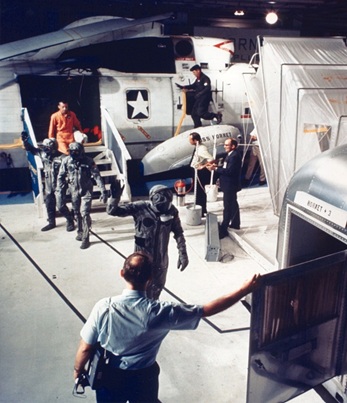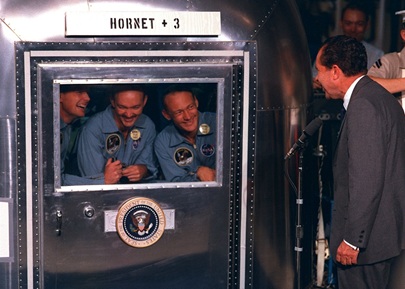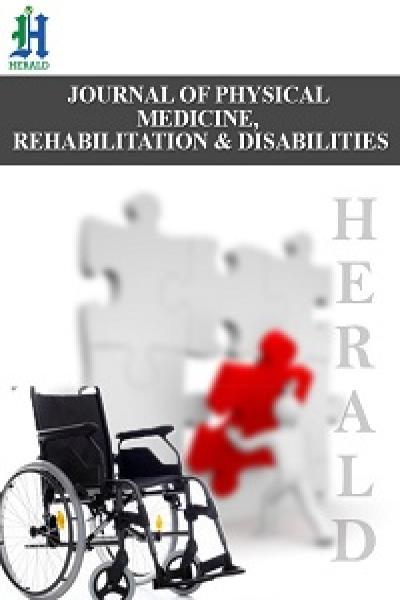
The Apollo 11 Crew and Microgravity
*Corresponding Author(s):
Alen J SalerianNeuroscience Institute, Zaimi 8, Paleo Faliro, Athens 17562, Greece
Tel:+306987428063,
Email:alensalerian@gmail.com
Abstract
This correspondence reviews the physical effects upon the arrival on earth of the Apollo 11 crew from the eight day space travel to the moon and back. Various biological responses including adaptation from microgravity to gravity are known to include symptoms of impaired gait, imbalance and dizziness from transient orthostatic hypotension.
On July 24th 1969, the Apollo 11 astronauts stood up without assistance walked normally and showed no apparent signs of physical or psychological distress. NASA reports of the Apollo missions to the moon and the scientific knowledge of biological effects of microgravity to astronaut health seem to be incompatible. It seems reasonable for NASA to provide a scientifically valid account of the Apollo moon missions before future manned missions to the moon and beyond.
INTRODUCTION
Recent NASA plans for two astronauts to spend 6.5 days on the moon highlight the challenges regarding health hazards in space identified by the Institute of Medicine’s report, “Safe Passage/Astronaut Care for Exploration Missions” (2001) [1]: Emphasis on the confidentiality of astronaut clinical data has resulted in lost opportunities to understand human physiological adaptations to space and concerns for the protection of privacy and over the implications regarding disclosure and use of clinical data may have led to the reporting of relevant in formation.
To date some 350 persons have flown into space, yet only the Apollo astronauts have traveled into deep space and walked on the moon[2,3]. Have physical hazards encountered during the historic first flight to the moon in 1969 received the attention they deserve? How did the Apollo crew deal with microgravity associated physical symptoms when they returned to the earth?
SPACE TRAVEL AND HUMAN BIOLOGY
Various biological responses associated with exposure to high levels of noise, radiation, relative immobility and weightlessness are expected to influence astronaut health upon return to the earth from space missions [1]. Of importance, adaptation from weightlessness and microgravity to gravity are known to include symptoms of impaired gait, imbalance and dizziness from transient orthostatic hypotension [4]. Also it has been reported that, CVP decreased and the left ventricular end-diastolic dimension measured by echocardiography increased from a mean of 4.60 cm supine preflight to 4.97 cm within 48 h in microG [4]. These data are consistent with increased cardiac filling early in microG [4].
Major cause of orthostatic hypotension is the persistent lowering peripheral vascular resistance during space travel and more than two thirds of all astronauts experience orthostatic hypotension when they reenter earth’s gravity[4]. Symptoms can last several days [4]. In addition some muscle atrophy is observed after five days of space travel [5].
APOLLO 11 CREW BEHAVIOR UPON ARRIVAL ON EARTH
On July 24, 1969, on the day of arrival on earth, after an eight day journey to the moon, Neil Armstrong,Michael Collins and Edwin Aldrin were observed on television by millions as they stood up without assistance, showed no signs of physical or psychological distress and walked normally on the deck of the aircraft carrier USS Hornet before entering the quarantine bus[4](Figure 1). Soon afterwards they were observed to be relaxed, smiling, exchanging words with president Nixon, again without any sign of distress [4](Figure 2). They did not seem to show any physical signs or symptoms associated with an eight daylong space travel, no evidence of fatigue, impaired balance, muscle weakness, dizziness, altered mood and mental function.
 Figure 1:The Apollo 11 crew,on US Hornet,July 24, 1969.
Figure 1:The Apollo 11 crew,on US Hornet,July 24, 1969.
 Figure 2:The Apollo 11 crew and president Nixon,July 24,1969.
Figure 2:The Apollo 11 crew and president Nixon,July 24,1969.
DISCUSSION
Wasitpossible for Armstrong, Collins and Aldrin not to show any signs of ill effects from micro gravity as they briskly walked some distance on the deck of US Hornet to board a vehicle on July 24,1969?. Was it possible for them to hide fatigue, dizziness, hypotension, or alterations of mental function? The Apollo 11 astronauts looked to be in perfect mental and physical state.
Their seemingly perfect appearance at the time of return to the earth stood in contrast to the scientific knowledge of biological effects of eight day space travel [1,4](Table 1). These inconsistencies seem to reflect either possible over-estimation or under-reporting of the health hazards summarized in safe passage.
|
Exposure to radiation |
|
Exposure to excessive noise |
|
Space sickness |
|
Muscle loss |
|
Microgravity |
|
Post microgravity orthostatic hypotension |
Table 1:Apollo 11 and Medical Challenges Associated with Space Travel of Eight Days.
CONCLUSION
Several medical inconsistencies regarding the Apollo 11 flight seem to reflect either possible over-estimation or under-reporting of the health hazards summarized in safe passage. It’s possible that due to the NASA’s dual civilian and military mission some crucial data are inaccessible to public knowledge. Regardless, NASA should provide a scientifically valid explanation about the medical inconsistencies regarding the Apollo 11 flight before future manned missions into deep space. Because the available data support the hypothesis that the Apollo astronauts did not make it to the moon but remained only in low earth orbit.
REFERENCES
- Ball JR, Evans Jr CH(2001) Safe Passage; Astronaut care for exploration missions.Institute of Medicine, National Academy Press, Washington, D.C, USA.
- Wisnewski G (2007),One Small Step, Clairview Books, East Sussex, London.
- Fetzer J H, Palacek M (2012) I suppose we did not go to the moon either. Moonrock Publishers.
- Buckey JC Jr, Lane LD, Levine BD, Watenpaugh DE, Wright SJ, et al. (1996) Orthostatic intolerance after spaceflight.J ApplPhysiol81:7-18.
- Edgerton VR, Zhou MY, Ohira Y, Klitgaard H, Jiang B, et al. (1995) Human fibersize and enzymaticproperties after 5 and 11 days of spaceflight. J ApplPhysiol78:1733-1739.
Citation: SalerianAJ (2019) The Apollo 11 Crew and Microgravity. J Phys Med Rehabil Disabil 5: 038.
Copyright: © 2019 Alen J Salerian, et al. This is an open-access article distributed under the terms of the Creative Commons Attribution License, which permits unrestricted use, distribution, and reproduction in any medium, provided the original author and source are credited.

